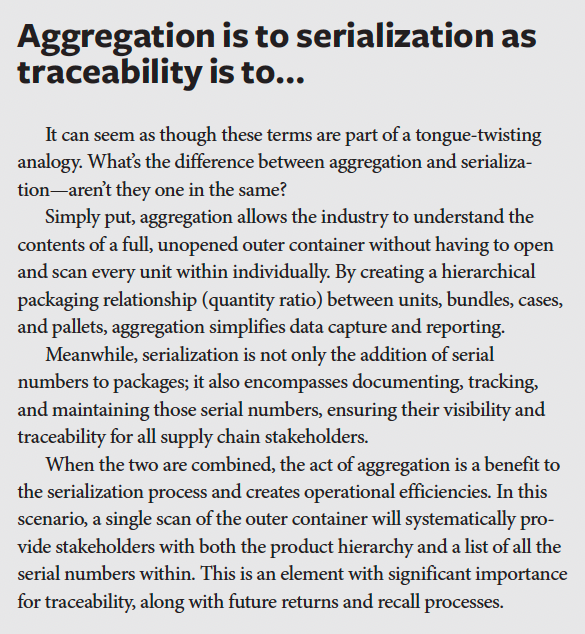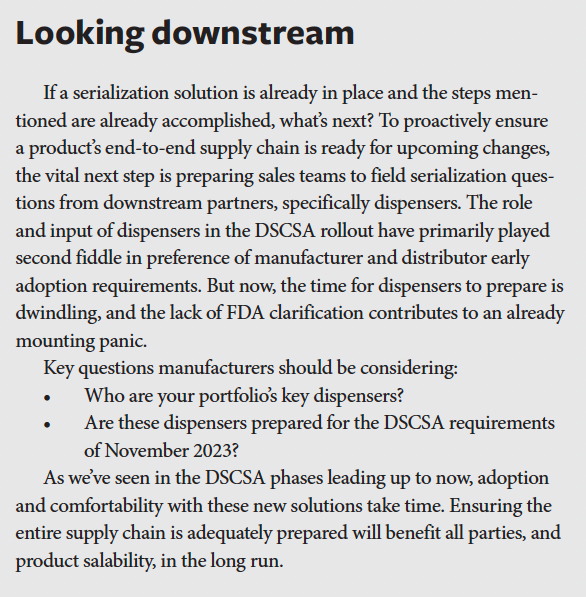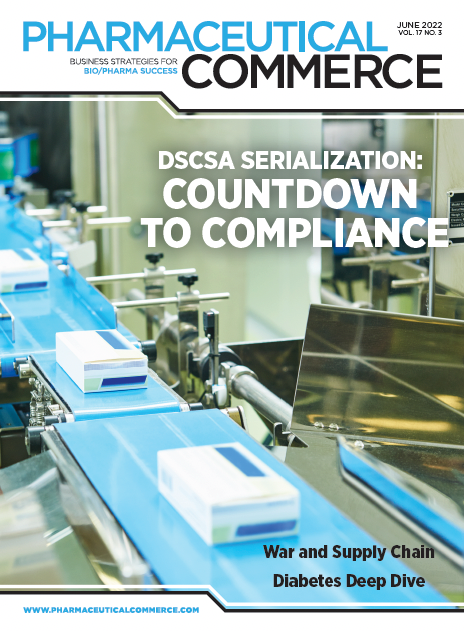The Key Steps Ahead of DSCSA D-Day
A recommended checklist for manufacturers as they enlist distributor and 3PL support—and the important questions they should be asking themselves

Requirements and implementation activities stemming from a phased rollout of the Drug Supply Chain Security Act (DSCSA) will be coming to a close on Nov. 27, 2023, barring a last-minute reprieve from FDA. At times, it has seemed as if the final phase of the DSCSA may never come to fruition, given the interim milestone timeline delays and a decade-long runway. But now, the finish line is finally in view, with less than 18 months until the DSCSA legislation’s goal of having complete traceability of the US pharma market.
Recently, there has been an increasing focus on this hot topic, highlighting the importance of DSCSA and the significant confusion still present in the market. Many manufacturers cite the lack of clarity, formal education, and official resources as the key drivers for not having a serialization solution in place today. This may also be why the upcoming DSCSA timelines create such confusion and frenzy. Whether companies were hoping to see additional timeline delays from FDA or simply lost track of time during the pandemic-induced void of 2020–2021, the time to act is now for companies without a full serialization solution in place.
DSCSA stipulates that by November 2023, the US will have an electronic, interoperable system that will monitor the movement of prescription drugs from manufacturing to dispensation.1

What does this mean for manufacturers?
There’s still time to implement solutions before November 2023, but not much. How much time is needed depends on what strides have already been taken toward preparation. When considering the breadth of manufacturers impacted by the DSCSA requirements and the limited resources available to implement such software connectivity, what time is left is precious. As heightened awareness cascades throughout the market, the backlog of manufacturers waiting to implement with distributor partners and third-party logistics (3PL) solution providers continues to grow. This backlog is not likely to diminish between now and November 2023.
According to the distributor serialization teams engaged with for this article, if a product isn’t yet aggregated, the “oh no!” moment is here. For manufacturers with inventory that is aggregated and serialized but who haven’t yet launched a total serialization solution with their trading partners, there is agreement that they should aim to begin implementation activities no later than this summer.
Some manufacturers question if the sense of urgency to aggregate inventory and implement end-to-end serialization programs is real—or if, instead, the haste is fabricated by trading partners for their own benefit. Manufacturers need to understand that the deadline and urgency are real. Companies’ aversion to risk may soon be a contributing factor to action over inaction.
Recommended next steps for manufacturers
- Identify whether your inventory is aggregated. If not, begin collaborating with your packager to understand their capabilities and establish product aggregation requirements. Consider how the timing of the next product run aligns with your packager’s abilities and the time needed to implement.
- Learn about your contracted 3PL’s serialization services and capabilities. 3PLs are creating a name for themselves, becoming very reputable sources of serialization services. The appetite for 3PLs to become more entrenched with their existing customer base and increase the opportunity for transactional fees is growing like never before. Select 3PLs even offer complete end-to-end serialization and software solutions in-house. Engage your 3PL to learn more about how they can help streamline serialization efforts.
- Enlist the support of an L4 serialization provider. For those who don’t leverage a 3PL or are keen on diversifying their service providers, there are numerous stand-alone serialization providers on the market, ready to assist with all serialization, reporting, and repository needs. The market has seen a sharp increase in 3PL providers eager for manufacturers to outsource support activities, so a myriad of service levels (and price points) await.
Pushing up deadlines
Key distributors are setting their own deadlines for manufacturers ahead of the DSCSA 2023 requirements—some inventory aggregation deadlines have been set as early as November 2022. This is to prevent bottlenecks in EPCIS data connectivity and obstacles to the FDA’s timeline. Additional distributors and trading partners will likely follow suit to mitigate procrastination impacts.
What level of enforcement will these distributors enact upon their deadlines? Will they require changes to returns policies as a result? That has yet to be seen. However, one thing is certain: trading partners do not want to be left holding onto unsaleable inventory after November 2023. They are leveraging their discretionary guidance granted by the FDA to protect themselves between now and then as best they can.
Reference
1. https://www.fda.gov/drugs/drug-supply-chain-integrity/drug-supply-chain-security-act-dscsa
About the Author

Shannon Hybner is Director at Archbow Consulting.
